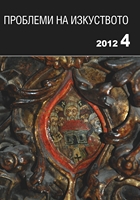Страници от хаджийския дневник: някои наблюдения върху православното християнско изкуство в Йерусалим и връзките му с балканската традиция
Pages of the Pilgrim’s Diary: Some Observations on the Christian Orthodox Art in Jerusalem and Its Connections with the Balkan Tradition during the Ot
Author(s): Emmanuel MutafovSubject(s): Fine Arts / Performing Arts
Published by: Институт за изследване на изкуствата, Българска академия на науките
Summary/Abstract: This text tries for the first time in art history to draw a general view of the development of the Christian Orthodox art in the Holy Land and in particular in Jerusalem from the 4th century to 1918. Starting with the origins of the Christian visual tradition related with the sacrifice of Jesus and his resur- rection in Palestine I essay to offer a critic chronological perusal of the presence of different cultures and visions of the divine in the Middle East with their interactions of the Early Byzantine and Islamic centers. The majority of the observations here however are devoted to the art of the Christian Orthodox community during the Ottoman period, which remains out of the serious interest of the scholars until our days. All the existing bibliography on this subject is presented and analyzed. I tried to follow the steps of the Bulgarian pilgrims and to find some interesting traces of their contact with the holiness of Loca Sancta on the basis of which some conclusions of their faith are made. New data is also provided especially for some late icons and art- ists in their connection with the Balkan tradition, Crete, Rhodos, Cyprus, Izmir, etc. The unique chance for me to work in person with the famous priest Daniel’s hermeneia helped me to provide some general conclusions on the existence of the treatises on painting in the Eastern tradition, their connection with Crete in the 16th century and to provide an unpublished owner’s note from the abovementioned manuscript here. As a typical product of Jerusalem art in my opinion could be determined only the 18-19th century production of the pilgrim’s oil-painted canvases made by local Melkit and other touring Orthodox masters, which is a sign for me to assert that Jerusalem is mainly a consumer of art than a creator of artistic trends just like Mount Athos of the same period was. At the end of this text several general topics are commented like: How are the various Orthodox cultures in Jerusalem defined and approached? What are their characteristics, similarities and/ or differences and to what extent can the term Post-Byzantine be valid here or is obsolete? Why Greeks preferred more Mount Sinai than the Holy Sepulchre? For centuries after the fall of the Byzantine Empire, Orthodox Christian populations continued to produce art within environments bearing no geographic, social, political, ecclesiastical uniformity whilst lacking the impact of a unifying centre. For sure Jerusalem was not such a centre, but the majority of the art preserved there is from the Ottoman period and has to be properly collected and studied. I wish to thank the Albright Institute for the award of the A. Mellon Fellowship and to the Greek Orthodox Patriarchate for giving me an access to their collections in 2012 which have afforded me an excellent opportunity to further my research.
Journal: Проблеми на изкуството
- Issue Year: 2012
- Issue No: 4
- Page Range: 3-14
- Page Count: 12
- Language: Bulgarian
- Content File-PDF

